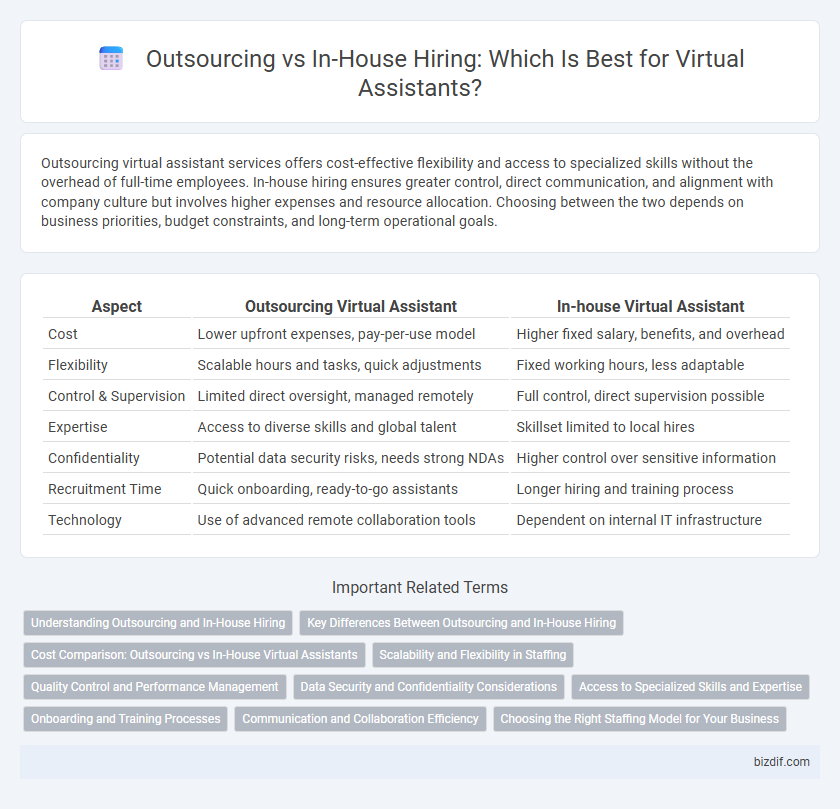Outsourcing virtual assistant services offers cost-effective flexibility and access to specialized skills without the overhead of full-time employees. In-house hiring ensures greater control, direct communication, and alignment with company culture but involves higher expenses and resource allocation. Choosing between the two depends on business priorities, budget constraints, and long-term operational goals.
Table of Comparison
| Aspect | Outsourcing Virtual Assistant | In-house Virtual Assistant |
|---|---|---|
| Cost | Lower upfront expenses, pay-per-use model | Higher fixed salary, benefits, and overhead |
| Flexibility | Scalable hours and tasks, quick adjustments | Fixed working hours, less adaptable |
| Control & Supervision | Limited direct oversight, managed remotely | Full control, direct supervision possible |
| Expertise | Access to diverse skills and global talent | Skillset limited to local hires |
| Confidentiality | Potential data security risks, needs strong NDAs | Higher control over sensitive information |
| Recruitment Time | Quick onboarding, ready-to-go assistants | Longer hiring and training process |
| Technology | Use of advanced remote collaboration tools | Dependent on internal IT infrastructure |
Understanding Outsourcing and In-House Hiring
Outsourcing virtual assistant services involves contracting external professionals or agencies to handle administrative tasks, providing flexibility and cost-efficiency without the need for internal resource allocation. In-house hiring requires recruiting full-time virtual assistants, offering greater control and direct oversight but often entails higher operational costs and longer onboarding times. Businesses evaluate these options based on factors like budget, scalability, and the level of control needed for managing virtual support functions.
Key Differences Between Outsourcing and In-House Hiring
Outsourcing virtual assistant services offers scalability and cost-efficiency by leveraging specialized external providers, whereas in-house hiring ensures direct control and alignment with company culture. Outsourced teams often provide diverse skill sets and flexible engagement models without the overhead costs of full-time employment. In contrast, in-house assistants offer immediate communication and deeper integration within internal workflows, enhancing long-term organizational knowledge retention.
Cost Comparison: Outsourcing vs In-House Virtual Assistants
Outsourcing virtual assistants often reduces operational costs by eliminating expenses related to employee benefits, office space, and equipment, making it a cost-effective solution for businesses. In-house hiring requires significant investment in recruitment, training, salaries, and ongoing administrative expenses, which can escalate the overall budget. Cost comparisons reveal that outsourcing provides scalable, flexible support while maintaining quality at a lower financial commitment than in-house virtual assistant teams.
Scalability and Flexibility in Staffing
Outsourcing virtual assistant services offers unmatched scalability, enabling businesses to quickly adjust staffing levels according to workload fluctuations without the constraints of long-term commitments. In-house hiring provides direct control but often lacks the flexibility to expand or reduce teams swiftly, which can impede responsiveness during business growth or seasonal demands. Prioritizing outsourced solutions allows companies to maintain operational agility while scaling efficiently with market needs.
Quality Control and Performance Management
Outsourcing virtual assistant services provides access to specialized skills and advanced performance tracking systems, enhancing quality control through standardized metrics and third-party audits. In-house hiring enables direct supervision and immediate feedback, facilitating tailored performance management but may lack the scalability and technological resources of outsourced solutions. Balancing these approaches depends on the organization's capacity for quality assurance and the complexity of performance evaluation desired.
Data Security and Confidentiality Considerations
Outsourcing virtual assistant tasks requires stringent data security protocols and confidentiality agreements to protect sensitive information from breaches inherent in third-party access. In-house hiring offers greater control over data privacy through direct supervision and internal access restrictions, reducing the risk of leaks associated with external service providers. Prioritizing robust cybersecurity measures and employee training in either approach is crucial to maintaining confidentiality and compliance with data protection regulations.
Access to Specialized Skills and Expertise
Outsourcing virtual assistant services provides immediate access to a diverse pool of specialized skills and expertise tailored to specific business needs. In-house hiring often requires extensive training and development to build the same level of proficiency, leading to higher costs and longer ramp-up times. Leveraging external virtual assistants enables businesses to quickly adapt to changing demands with highly skilled professionals in areas like digital marketing, customer support, and administrative tasks.
Onboarding and Training Processes
Outsourcing virtual assistant services significantly reduces onboarding and training time by leveraging pre-trained professionals with specialized skills, ensuring immediate productivity. In-house hiring requires considerable investment in recruitment, detailed onboarding, and continuous training to align assistants with company-specific processes and culture. Efficient onboarding workflows and structured training programs in an in-house setting impact overall time-to-competency, often extending project ramp-up periods compared to outsourced solutions.
Communication and Collaboration Efficiency
Outsourcing virtual assistant services often leverages advanced communication platforms and time zone flexibility to enhance collaboration efficiency, reducing delays in task completion. In-house hiring provides direct face-to-face interaction and immediate feedback, fostering stronger team cohesion and quicker problem resolution. Selecting between outsourcing and in-house depends on balancing communication clarity, real-time collaboration needs, and operational costs.
Choosing the Right Staffing Model for Your Business
Outsourcing virtual assistant services offers cost-efficiency and access to a global talent pool, while in-house hiring ensures greater control and alignment with company culture. Businesses must evaluate factors such as budget, required expertise, communication preferences, and scalability needs to determine the optimal staffing model. Selecting the right approach impacts operational efficiency, task management, and long-term business growth.
Outsourcing vs In-house hiring Infographic

 bizdif.com
bizdif.com